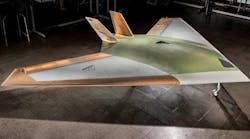Teaming with The University of Manchester, BAE Systems has developed an unmanned aerial vehicle (UAV) that uses blown air, rather than wing flaps or other moving parts, for maneuvering the aircraft. Called the MAGMA, the small aircraft represents a new concept in UAVs which may pave the way for a new generation of stealthier UAVs. The design removes the need for complex moving parts to move wing flaps to control the aircraft during flight. The blown-air approach offers greater control than moving parts, with the potential to significantly reduce aircraft weight and maintenance costs. The technology is expected to lead to lighter, faster, more efficient, and stealthier UAVs for military and civil applications in the future.
The MAGMA (see figure) is the first aircraft to employ the blown-air maneuvering technique as part of flight trials. The jet-powered UAV will incorporate the novel approach in the form of two technologies: wing circulation control and fluidic thrust vectoring. The first technology takes air from the aircraft engine and blows it supersonically through the trailing edge of the wing to provide control of the aircraft during flight. The second technology uses blown air to deflect the exhaust, so that the direction of the aircraft can be changed according to the vector of the blown exhaust air.
BAE Systems and the University of Manchester are partnering on the flight trials as part of an ongoing project meant to develop innovative flight control technology. “The technologies we are developing with the University of Manchester will make it possible to design cheaper, higher-performance, next-generation aircraft,” said Clyde Warsop, engineering fellow at BAE Systems. “Our investment in research and development drives continued technological improvements in our advanced military aircraft, helping to ensure UK aerospace remains at the forefront of the industry and that we retain the right skills to design and build the aircraft of the future.”
“These trials are an important step forward in our efforts to explore adaptable airframes,” added Bill Crowther, senior academic and leader of the MAGMA project at the University of Manchester. “What we are seeking to do through this program is truly ground-breaking.”
BAE Systems has invested ₤4.4 billion in R&D over the past five years on UAVs and other systems of benefit to military applications. Efforts to improve UAV performance are also being conducted along with the University of Arizona and the NATO Science and Technology Organization.

